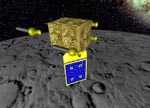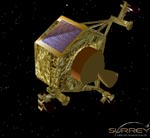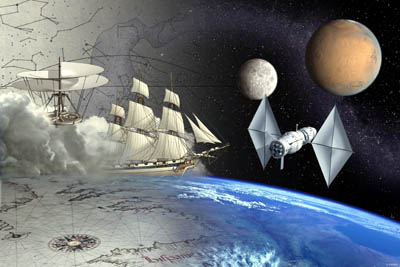
_______________________________________________________
Consultations were hosted by the
European Space Agency (ESA) and the
British National Space Centre (BNSC) in Edinburgh 8/9th January 2007.
Representatives from the UK and other European political, industrial and scientific sectors, together with members of the general public, the various stakeholder groups in Europe with colleagues from across the world, debated the future long-term exploration of the solar system and beyond.
The UK has a vibrant space science and industrial community that already makes a significant contribution to our knowledge economy. Its experience in developing innovative space technology will continue to ensure the UK plays a leading role in both European and global space exploration in the future.
 MoonLITE Credit: SSTL
MoonLITE Credit: SSTLMoonLITE equipped with missile-shaped penetrators carrying seismometers to investigate the lunar interior and a telecommunications capability to demonstrate high data rate telecoms at the Moon.
 Moonraker Credit: SSTL
Moonraker Credit: SSTLMoonRaker, a small propulsive Lander to provide in-situ geological dating.
These mission options exemplify the UK's expertise in small satellites, robotics and miniaturised instruments and MoonLITE's telecoms capability could provide a vital contribution to NASA's ambition of establishing a Moon base by 2020.
The UK is already the second largest European contributor to ESA's Aurora programme of planetary exploration and is currently involved in developing an ambitious Mars Rover project that will fly onboard Europe's ExoMars mission to the Red Planet slated for launch in 2013.

_______________________________________________________
ESA's Aurora MissionFrom the dawn of humankind the need to explore has driven expansion across our planet. Today this expansion continues towards other planets in the solar system by means of robotic spacecraft - virtual explorers. But will human expansion continue? In the public consciousness this is only a matter of time. By 2025 an international human mission to Mars may be a reality. It may use the Moon as a way station and to prepare for the great leap. The feasibility of such a mission is being assessed, however, the necessary technology and capability still need to be developed.
Over the next 20 years robotic missions will prepare for human missions, by collecting as much scientific and engineering data as possible, without human scientists in situ. These robotic missions will contribute and demonstrate the technologies needed to put humans on Mars and return them safely to our planet.
Some of the key technologies for a human mission are also very important to the search for life in situ on the red planet and on other solar systems, planets and moons. Soft and precision landing, drilling and sample return, will not just be demonstrated for the sake of technology. These missions will carry sophisticated exobiology payloads and provide answers to some key questions on the origin of life in the solar system and possible causes for its extinction.
A challenging and complex return mission to collect a sample on Mars might also involve our first attempt at interplanetary exploitation. Instead of lugging propellant for the return trip all the way from Earth, the lander systems could include technology that would generate rocket fuel from Martian resources.
Ultimately, though, Mars exploration plans should result in an even greater adventure - a human mission. Astronauts are vastly more capable than even the smartest robot, but they are also vastly more difficult and expensive to transport. Unlike robots, they eat and breath; and if their environment is too uncomfortable, they can become tetchy and depressed. For a human Mars expedition to be possible, new technologies will have to be developed and tested: not only soft-landing methods and in-situ fuel processing, but life-support engineering for a long haul far from home and perhaps entirely new rocket systems, possibly based on new types of propulsion, which will reduce the time spent coasting through space.
By 2025 A human Mars mission, perhaps with the Moon as a first target or even as a way station to the Red Planet, would represent the culmination of the programme's efforts. And just incidentally, it would also guarantee that there was life on Mars: human life.Read more European workshop on space exploration from ESA
Europe forges long-term strategy for Space Exploration by PPARC_______________________________________________________
_______________________________________________________
Labels: Aurora, Earth, ESA, Mars













The crew will have tasks similar to those they would have on a real space mission. They will have to cope with simulated emergencies; they may even have real emergencies or illnesses. Communication delays of as much as 20 minutes each way will not make life any easier.
Instead of having a spacecraft as their home, the crew will live in a series of metal tanks. Using narrow connecting passages, they can move between a medical area, a research area, a crew compartment and a kitchen – an area of only 200m2. There is even a special tank representing the Mars descent vehicle for simulation of a stay on the Martian surface.
Why is ESA participating in this study?
To look at the psychology of such a mission, knowing that you are enclosed for 500 days. As soon as there is a problem, the crew knows that they are on their own, and they have to solve it themselves. The only help available from the outside is through communications which may take up to 40 minutes.
At the start of their mission the crew will be supplied with all the food they will have to live off for the duration of the study. They have to keep track of their consumables amongst themselves. This limited food supply could lead to additional tensions amongst the crew.
To look at the psychological effects of the situation on your mental well-being, and on your capabilities of performing certain tasks, even tasks critical to the mission. In a real mission, for example, whether you are able to land a vehicle on the surface of Mars, and are you able to do the science once you are there? How will group relations evolve? What are the potential dangers we could encounter? What kind of countermeasures can we invent that can prevent this? And to learn about what types of personality we should select for a real mission.
Almost as important, to learn more about the medical procedures. How do you define a good medical environment so that you can treat diseases? What are the medicines that you want to take with you on the journey? There will be one person amongst the crew with real medical training. But of course that person can also fall ill. So you have to have all kinds of back-up scenarios.
A full simulation should alert us to any potential risks and better prepare us for the real thing.
The Concordia Station is a scientific base built in Antarctica by the French Polar Institute (IPEV) and the Italian Antarctic Programme (PNRA) .
Read more ESA prepares for a human mission to Mars 02 April 2007.